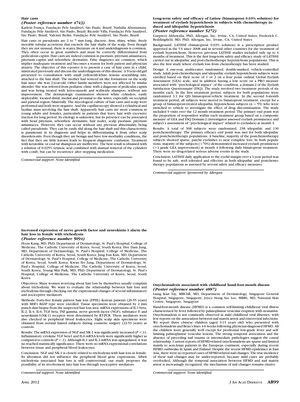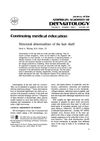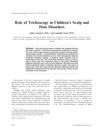Hair Casts
March 2012
in “
Journal of The American Academy of Dermatology
”
hair casts pseudonits pediculosis capitis retinoic acid female pattern hair loss FPHL trichodynia nerve growth factor NGF neurokinin-1 receptor NK-1 receptor LATISSE bimatoprost eyelash hypotrichosis onychomadesis Beau's lines hand-foot-mouth disease HFMD head lice scalp pain eyelash thinning nail shedding horizontal grooves on nails

TLDR Hair casts are often mistaken for head lice, scalp pain in hair loss is linked to certain nerve factors, eyelash growth treatment is safe and effective, and nail shedding in children may follow hand-foot-mouth disease.
The document presents four separate studies or case reports, each discussing different dermatological conditions and findings:
1. Hair casts, also known as pseudonits, are tubular accretions that encircle the hair shafts and are often misdiagnosed as pediculosis capitis (head lice). A case of a 9-year-old girl is presented where hair casts were initially mistaken for nits. The study emphasizes the importance of correct diagnosis to avoid unnecessary treatments. Hair casts are more common in young adults and females, especially those who keep their hair in excessive traction for long periods. The etiology is unknown, but they can be associated with various scalp conditions or occur independently. Treatment with 0.025% retinoic acid and manual removal is effective, but recurrence is possible after stopping medication.
2. A study involving 45 female Korean patients with female pattern hair loss (FPHL) and trichodynia (scalp pain associated with hair loss) found increased mRNA expression of nerve growth factor (NGF) and neurokinin-1 (NK-1) receptor, suggesting a relationship between these nociceptive mediators and trichodynia in hair loss.
3. A long-term safety and efficacy study of LATISSE (bimatoprost 0.03% solution) for treating eyelash hypotrichosis in 368 subjects with idiopathic or chemotherapy-induced hypotrichosis showed that daily application for one year was safe, well-tolerated, and effective in increasing eyelash prominence.
4. Three cases of onychomadesis (nail shedding) and Beau's lines (horizontal grooves on nails) are reported in children following hand-foot-mouth disease (HFMD), suggesting a causal relationship. The incidence of nail changes post-HFMD may be underreported, and the mechanism behind these changes remains unclear.
Each section of the document provides insights into different dermatological conditions, their diagnosis, and treatment options, highlighting the importance of accurate diagnosis and the potential for underdiagnosis or misdiagnosis in dermatology.




